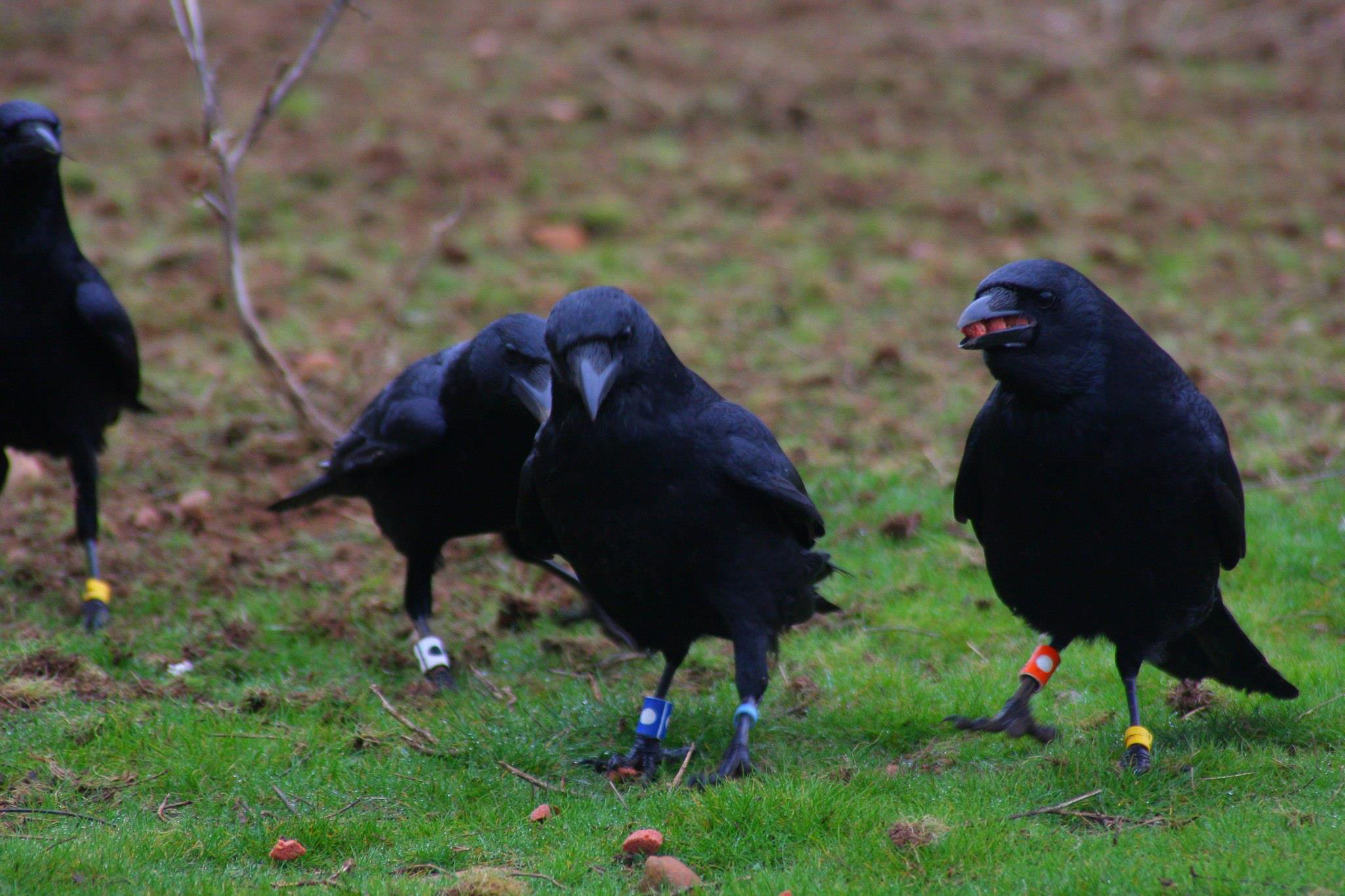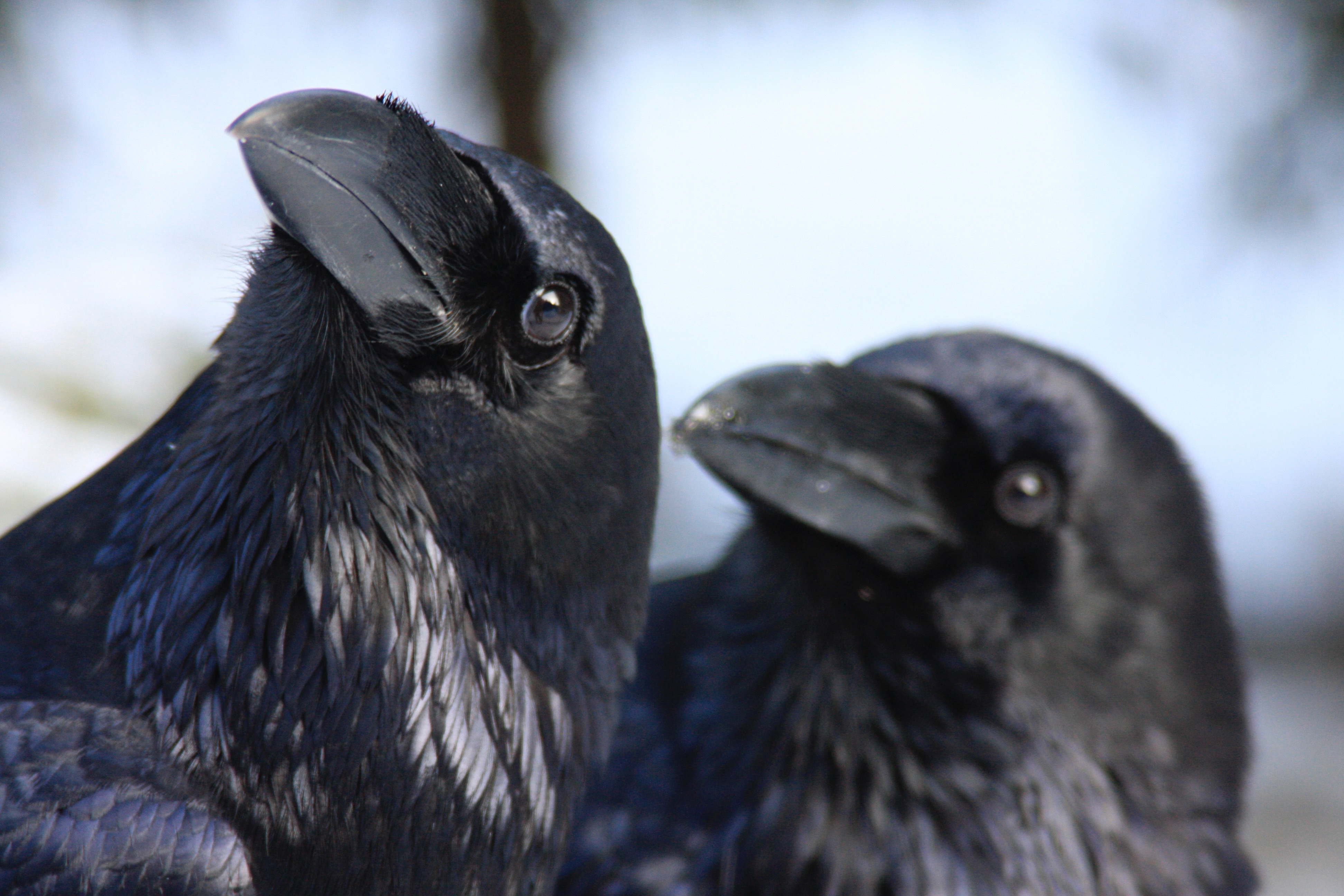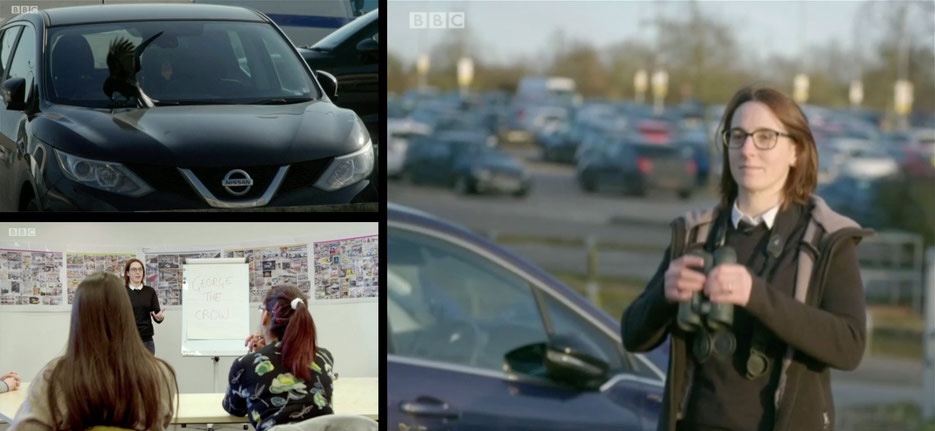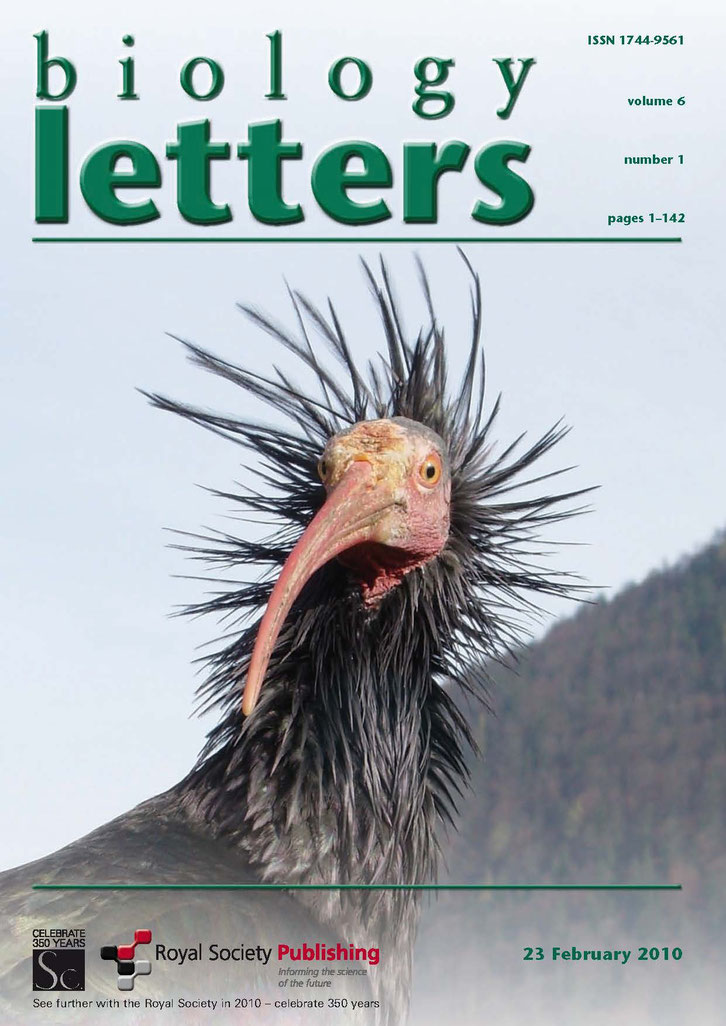Wascher, C.A.F. , Hennigh-Palermo, W. 2025. Responses of wintering corvids to New Year’s Eve fireworks in Berlin.
Behaviour, 1, 1-22 https://doi.org/10.1163/1568539X-bja10322.
[
link to download]
Wascher, C.A.F. . 2025. Collective behavior: The cost of leadership.
Current Biology, 35(16), R804 - R806 https://doi.org/10.1016/j.cub.2025.07.003.
[
link to download]
Wascher, C.A.F. , Youngblood, M. 2025. Vocal efficiency in crows.
Animal Cognition, 28(1), 1-11 https://doi.org/10.1007/s10071-025-01985-8.
[
link to download]
Daw F., Beheim B.A.,
Wascher C.A.F.. 2025.
Evolutionary drivers of food caching in corvids.
Animal Cognition, 28, 17. https://doi.org/10.1007/s10071-025-01938-1
[
link to download]
Wascher C.A.F., Reynolds S. 2025.
Vocal communication in corvids: A systematic review.
Animal Behaviour, 221, 123073. doi.org/10.1016/j.anbehav.2024.123073
[
link to download]
Kershenbaum, A., Akçay, Ç., Babu-Saheer, L., Barnhill, A., Best, P., Cauzinille, J., Clink, D., Dassow, A., Dufourq, E.,
Growcott, J., Markham, A., Marti-Domken, B., Marxer, R., Muir, J., Reynolds, S., Root-Gutteridge, H., Sadhukhan, S., Schindler, L.,
Smith, B.R., Stowell, D.,
Wascher, C.A.F., Dunn, J.C. 2024. Automatic detection for bioacoustic research: a
practical guide from and for biologists and computer scientists. Biological Reviews, doi: 10.1111/brv.13155
[
link to download]
Wascher C.A.F., Hillemann F. 2024.
Observation of female-male mounting in the carrion crow.
Behavioural Processes, 105055. DOI:10.1016/j.beproc.2024.105055
[
link to download]
Wascher C.A.F. 2023.
Cognition: Crows are natural statisticians.
Current Biology, 33, R808-R810. DOI:10.1016/j.cub.2023.06.073
[
link to download]
Steinbrecher F., Dunn J.C., Price E.C., Buck L.H.,
Wascher C.A.F., Clark F.E. 2023 .
The effect of anthropogenic noise on foraging and vigilance in zoo-housed pied-tamarins.
Applied Animal Behaviour Science, 105989. DOI:10.1016/j.applanim.2023.105989
[
link to download]
Wascher C.A.F., Allen K. & Szipl G. 2021.
Learning and motor inhibitory control in crows and domestic chickens.
Royal Society Open Science, 8, 210504210504, DOI:10.1098/rsos.210504
[
link to download]
Kok A.C.M., Berkhout B., Carlson N., Evans N., Khan N., Potvin D., Radford A.N., Sebire M., Shafiei Sabet S., Shannon G. &
Wascher C.A.F. 2023.
How chronic anthropogenic noise can affect communities.
Frontiers in Ecology and Evolution, 11, 289. DOI:0.3389/fevo.2023.1130075
[
link to download]
Mäses M. &
Wascher C.A.F. 2023.
Assessing cats’ (
Felis catus) sensitivity to human pointing gestures.
Journal of Comparative Psychology, 137(1), 38–44. DOI:10.1037/com0000338
[
link to download]
Dunn J.C., Akçay C.†, Balasubramaniam K. †, Miller R. † &
Wascher C.A.F. †. 2023.
Conceptualization, context, and comparison are key to understanding the evolution of fear.
Behavioral and Brain Sciences, 46, e61. DOI:10.1017/S0140525X22001789 †These authors contributed equally.
[
link to download]
Wascher C.A.F., Arnold W. & Kotrschal K. 2022.
Effects of severe anthropogenic disturbance onto heart rate and body temperature in free-living greylag geese (
Anser anser).
Conservation Physiology, 10(1), coac050. DOI:10.1093/conphys/coac050
[
link to download]
Logan C.J., McCune K.B., MacPherson M., Johnson-Ulrich Z., Rowney C., Seitz B., Blaisdell A.P., Deffner D., &
Wascher C.A.F. 2022.
Are the more flexible great-tailed grackles also better at behavioral inhibition?
Animal Behavior and Cognition, 9(1), 14-36. DOI:10.26451/abc.09.01.03.2022
[
link to download]
Wascher C.A.F., Baur N., Hengl M., Köck C., Pegger T., Schindlbauer J., & Wemer L. 2021.
Behavioural responses of captive corvids to the presence of visitors.
Animal Behavior and Cognition, 8(4), 481-492. DOI:10.26451/abc.08.04.03.2021
[
link to download]
Wascher C.A.F. 2021.
Heart rate as a measure of emotional arousal in evolutionary biology.
Philosophical Transactions of the Royal Society B, 376, 20200479. DOI:10.1098/rstb.2020.0479
[
link to download]
Khan N. &
Wascher C.A.F. 2021.
Considering generalizability: A lesson from auditory enrichment research on zoo animals.
Animal Behavior and Cognition, 8(2), 251-262. DOI:10.26451/abc.08.02.12.2021
[
link to download]
Wascher C.A.F. 2021.
Association between social factors and gastrointestinal parasite product excretion in a group of non-cooperatively breeding carrion crows.
Behavioral Ecology and Sociobiology, 75, 30. DOI:10.1007/s00265-021-02967-9
[
link to download]
Dufour V., Broihanne M.-H. &
Wascher, C.A.F. 2020.
Corvids avoid odd evaluation by following simple rules in a risky exchange task.
Ethology, 126(2), 153-164. DOI:10.1111/eth.12994
[
link to download]
Wascher C.A.F., Feider B., Bugnyar T. & Dufor, V. 2020.
Crows and common ravens do not reciprocally exchange tokens with a conspecific to gain food rewards.
Ethology, 126(2), 278-287. DOI:10.1111/eth.12970
[
link to download]
Wascher C.A.F., Canestrari D. & Baglione V. 2019.
Affiliative social relationships and coccidian oocyst excretion in a cooperatively breeding bird species.
Animal Behaviour, 158, 121-130. DOI:10.1016/j.anbehav.2019.10.009
[
link to download]
Halsey L.G., Green J.A., Twiss S.D., Arnold W., Burthe S.J., Butler P.J., Cooke S.J., Grémillet D., Ruf T., Hicks O., Minta K.J., Prystay T.S.,
Wascher C.A.F. & Careau V. 2019.
Flexibility, variability and constraint in energy management patterns across vertebrate taxa revealed by long-term heart rate measurements.
Functional Ecology, 33(2). 260-272. DOI:10.1111/1365-2435.13264
[
link to download]
Frigerio D., Hemetsberger F. &
Wascher C.A.F. 2019.
How having a partner and a family changes the stress levels of graylag geese.
Frontiers for Young Minds, 7, 68. DOI:10.3389/frym.2019.00068
[
link to download]
Miller R., Boeckle M., Jelbert S.A., Frohnwieser A.,
Wascher C.A.F. & Clayton N.S. 2019.
Self-control in crows, parrots and non-human primates.
WIREs Cognitive Science, e1504. DOI:10.1002/wcs.1504
[
link to download]
Safryghin A., Hebesberger D.V. &
Wascher C.A.F. 2019.
Testing for behavioral and physiological responses of domestic horses (
Equus caballus) across different contexts — consistency over time and effects of context.
Frontiers in Comparative Psychology, 10, 849. DOI:10.3389/fpsyg.2019.00849
[
link to download]
Szipl G., Loth A.,
Wascher C.A.F., Hemetsberger J., Kotrschal K., Frigerio D. 2019.
Parental behaviour and family proximity as key to gosling survival in Greylag geese (
Anser anser).
Journal of Ornithology, 160, 473–483. DOI:10.1007/s10336-019-01638-x
[
link to download]
Broihanne M.H., Romain A., Call J., Thierry B.,
Wascher C.A.F., De Marco A., Verrier D. & Dufour V. 2018.
Monkeys (Sapajus apella and Macaca tonkeana) and great apes (
Gorilla gorilla,
Pongo pygmaeus,
Pan paniscus and
Pan troglodytes) play for the highest bid.
Journal of Comparative Psychology, 133(3), 301. DOI:10.1037/com0000153
[
link to download]
Kirk J. &
Wascher C.A.F. 2018.
Temporal modification of social interactions in response to changing group demographics and offspring maturation in African lions (
Panthera leo).
Behavioural Processes, 157, 519-527. DOI:0.1016/j.beproc.2018.06.006
[
link to download]
Puehringer-Sturmayr V.,
Wascher C.A.F., Loretto M.-C., Palme R., Stoewe M., Kotrschal K. & Frigerio D. 2018.
Seasonal differences of corticosterone metabolite concentrations and parasite burden in northern bald ibis (
Geronticus eremita): The role of affiliative interactions.
PLoS ONE 13(1), e0191441. DOI:10.1371/journal.pone.0191441
[
link to download]
Wascher C.A.F.†, Kulahci, I.G.†, Langley E. & Shaw R. 2018.
How does cognitive performance shape patterns of social relationships?
Philosophical Transactions of the Royal Society B, 373, 20170293. DOI:10.1098/rstb.2017.0293 †These authors contributed equally.
[
link to download]
Wascher C.A.F., Kotrschal K. & Walter A. 2018.
Free-living Greylag geese adjust their heart rates and body core temperatures to season and reproductive context.
Scientific Reports, 8, 2142. DOI:10.1038/s41598-018-20655-z
[
link to download]
Frigerio D., Ludwig S.C., Hemetsberger J., Kotrschal K. &
Wascher C.A.F.. 2017.
Social and environmental factors modulate leucocyte profiles in free-living Greylag geese (
Anser anser).
PeerJ, 5, e2792. DOI:10.7717/peerj.2792
[
link to download]
Frigerio D., Cibulski L., Ludwig S.C., Campderrich I., Kotrschal K. &
Wascher C.A.F. 2016.
Parasite excretion patterns during the reproductive season in Northern Bald Ibis (
Geronticus eremita).
Journal of Ornithology, 157, 839-851. DOI:10.1007/s10336-015-1317-z
[
link to download]
Wascher C.A.F., Hemetsberger J., Kotrschal K. & Frigerio D. 2017.
Leucocyte profiles and family size in fledgling Greylag Geese (
Anser anser).
Avian Biology Research, 10(4), 246-252. DOI:10.3184/175815617X15036738758871
[
link to download]
Wascher C.A.F., Hillemann F., Canestrari D., & Baglione V. 2015.
Carrion crows learn to discriminate between calls of reliable and unreliable conspecifics.
Animal Cognition, 18, 1181-1185. DOI:10.1007/s10071-015-0879-8
[
link to download]
Szipl G., Boeckle M., Spreafico M.,
Wascher C.A.F. & Bugnyar T. 2015.
With whom to dine? Ravens' responses to food-associated calls depend on individual characteristics of the caller.
Animal Behaviour, 99, 33-42. DOI:10.1016/j.anbehav.2014.10.015
[
link to download]
Wascher C.A.F. 2015.
Individual performance in socio-cognitive tasks predicts social performance in carrion crows.
Behaviour, 152, 615–634. DOI:10.1163/1568539X-00003245
[
link to download]
Wascher C.A.F., Heiss, R., Baglione V. & Canestrari D. 2015.
Behavioural responses to olfactory cues in social contexts in carrion crows (
Corvus corone corone).
Behavioural Processes, 111, 1-5. DOI:10.1016/j.beproc.2014.11.009
[
link to download]
Dorn S.,
Wascher C.A.F. & Kotrschal, K. 2014.
Ambient temperature and air pressure modulate hormones and behavior in Greylag geese (
Anser anser) and Northern bald ibis (
Geronticus eremita).
Behavioural Processes, 108, 27-35. DOI:10.1016/j.beproc.2014.08.026
[
link to download]
Cibulski L.,
Wascher C.A.F., Weiß B.M. & Kotrschal, K. 2014.
Familiarity with the experimenter influences the performance of Common ravens (
Corvus corax) and Carrion crows (
Corvus corone corone) in cognitive tasks.
Behavioural Processes, 103, 129-137. DOI:10.1016/j.beproc.2013.11.013
[
link to download]
Hillemann F., Bugnyar T., Kotrschal K. &
Wascher C.A.F. 2014.
Waiting for better, not for more: corvids respond to quality in two delay maintenance tasks.
Animal Behaviour, 90, 1-10. DOI:10.1016/j.anbehav.2014.01.007
[
link to download]
Wascher C.A.F., Valdez J.W., Nuñez C., Baglione V. & Canestrari D. 2014.
Social factors modulating attention patterns in carrion crows (
Corvus corone corone).
Behaviour, 151(5), 555-572. DOI:10.1163/1568539X-00003148
[
link to download]
Teschke I.,
Wascher C.A.F., Scriba M., von Bayern A., Huml V., Siemers B. & Tebbich S. 2013.
Did tool-use evolve with enhanced physical cognitive abilities?
Philosophical Transactions of the Royal Society B, 368, 20120418. DOI:10.1098/rstb.2012.0418
[
link to download]
Wascher C.A.F. & Bugnyar T. 2013.
Behavioral Responses to Inequity in Reward Distribution and Working Effort in Crows and Ravens.
PLoS ONE, 8(2), e56885. DOI:10.1371/journal.pone.0056885
[
link to download]
Wascher C.A.F., Bauer A.C., Holtmann A.R. & Kotrschal K. 2012.
Environmental and social factors affecting excretion of intestinal parasite eggs and oocysts in a flock of free-living greylag geese (
Anser anser).
Behavioral Ecology, 23 (6), 1276-1283. DOI:10.1093/beheco/ars113
[
link to download]
Wascher C.A.F., Dufour V. & Bugnyar T. 2012.
Carrion crows cannot overcome impulsive choice in a quantitative exchange task.
Frontiers in Comparative Psychology, 3, 118. DOI:10.3389/fpsyg.2012.00118
[
link to download]
Wascher C.A.F., Szipl G., Boeckle M. & Wilkinson A. 2012.
You sound familiar — Carrion crows can differentiate between the calls of known and unknown heterospecifics.
Animal Cognition, 15, 1015-1019. DOI:10.1007/s10071-012-0508-8
[
link to download]
Wascher C.A.F., Weiß B.M., Arnold W. & Kotrschal K. 2012.
Physiological implications of pair-bond status in greylag geese.
Biology Letters, 8, 347-350. DOI:10.1098/rsbl.2011.0917
[
link to download]
Dufour V.,
Wascher C.A.F., Braun A., Miller R. & Bugnyar T. 2012.
Corvids can decide if a future exchange is worth waiting for.
Biology Letters, 8, 201-204. DOI:10.1098/rsbl.2011.0726
[
link to download]
Wascher C.A.F., Scheiber I.B.R., Braun A. & Kotrschal K. 2011.
Heart rate responses to induced challenge situations in greylag geese (
Anser anser).
Journal of Comparative Psychology, 125(1), 116-119. DOI:10.1037/a0021188
[
link to download]
Wascher C.A.F., Fraser O.N. & Kotrschal K. 2010.
Heart rate during conflicts predicts post-conflict stress-related behavior in greylag geese.
PLoS ONE, 5 (12), e15751. DOI:10.1371/journal.pone.0015751
[
link to download]
Kralj-Fiser S., Scheiber I.B.R., Kotrschal K., Weiß B.M. &
Wascher C.A.F. 2010.
Glucocorticoids enhance and suppress heart rate and behaviour in time dependent manner in greylag geese (
Anser anser).
Physiology & Behavior, 100, 394-400. DOI:10.1016/j.physbeh.2010.04.005
[
link to download]
Wascher C.A.F., Scheiber I.B.R., Weiß B.M. & Kotrschal K. 2009.
Heart rate responses to agonistic encounters in greylag geese (
Anser anser).
Animal Behaviour, 77, 955-961. DOI:10.1016/j.anbehav.2009.01.013
[
link to download]
Scheiber I.B.R., Weiß B.M., Hirschenhauser K.,
Wascher C.A.F., Nedelcu I.T. & Kotrschal K. 2008.
Does ‚relationship intelligence’ make big brains in birds?
The Open Biology Journal, 1, 6-8. DOI:10.2174/1874196700801010006
[
link to download]
Wascher C.A.F., Arnold W. & Kotrschal K. 2008.
Heart rate modulation by social contexts in Greylag geese (
Anser anser).
Journal of Comparative Psychology, 122(1), 100-107. DOI:10.1037/0735-7036.122.1.100
[
link to download]
Wascher C.A.F., Scheiber I.B.R. & Kotrschal K. 2008.
Heart rate modulationin bystanding geese watching social and non-social events.
Proceedings of the Royal Society London Series B, 275, 1653-1659. DOI:10.1098/rspb.2008.0146
[
link to download]
Book Chapters
Wascher C.A.F. 2022. Corvids.
In: Vonk J. & Shackelford, T.K. (eds.) Encyclopedia of Animal Cognition and Behavior.
Springer: 1733–1744. DOI:10.1007/978-3-319-55065-7_1799. ISBN:978-3-319-55064-0.
[
link to download]
Wascher C.A.F. & Kotrschal K. 2013. The costs of sociality measured through heart rate modulation.
In: Scheiber I.B.R., Weiß B, Hemetsberger J. & Kotrschal K. (eds.) The Social Life of Greylag Geese. Patterns, Mechanisms and Evolutionary Function in an Avian Model System.
Cambridge University Press: 142-155. DOI:10.1017/CBO9781139049955.012. ISBN:9780521822701.
[
link to download]




